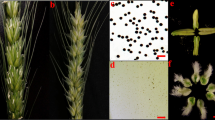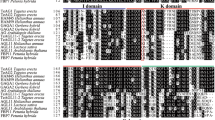Abstract
Homeotic transformation of stamens into pistil-like structures, called pistillody, has been reported in some alloplasmic common wheat lines with Aegilops crassa cytoplasm. An alloplasmic line of Chinese Spring ditelosomic 7BS (CSdt7BS) with Ae. crassa cytoplasm lacking the long arm of the chromosome 7B shows pistillody, and the pistils and transformed stamens are sterile due to abnormal ovule development. To elucidate the molecular mechanism of the ovule abnormality, we compared the expression profiles of floral organs between euplasmic and alloplasmic CSdt7BS lines. Two differential display methods of mRNA profiling demonstrated that Ae. crassa cytoplasm largely affects nuclear gene expression profiles of common wheat. Of the differentially expressed genes, a wheat AINTEGUMENTA (ANT) homolog, WANT-1, was preferentially expressed in pistils but not in stamens, and accumulation of the transcript was limited to ovule primordia at the floral organ development stage. In alloplasmic wheat, WANT-1 expression was patchy and weak at the ovule-development stages. On the other hand, no significant difference in gene expression patterns of wheat AGAMOUS (AG) homologs (WAG-1 and WAG-2) was observed between fertile and sterile pistils. These results indicated that alteration of gene expression after initiation of ovule primordia results in abnormal ovule development, and that the aberrant ovule formation is at least partly associated with the weak expression of WANT-1 around ovule primordia in alloplasmic wheat with Ae. crassa cytoplasm.








Similar content being viewed by others
References
Ambrose BA, Lerner DR, Ciceri P, Padilla CM, Yanovsky MF, Schmidt RJ (2000) Molecular and genetic analyses of the Silky1 gene reveal conservation in floral organ specification between eudicots and monocots. Mol Cell 5:569–579
Angenent GC, Franken J, Busscher M, van Dijken A, van Went JL, Dons HJM, van Tunen AJ (1995) A novel class of MADS box genes is involved in ovule development. Plant Cell 7:1569–1582
Baker SC, Robinson-Beers K, Villanueva JM, Gaiser JC, Gasser CS (1997) Interactions among genes regulating ovule development in Arabidopsis thaliana. Genetics 145:1109–1124
Boutilier K, Offringa R, Sharma VK, Kieft H, Quellet T, Zhang LM, Hattori J, Liu CM, van Lammeren AAM, Miki BLA, Custers JBM, Campagne MMV (2002) Ectopic expression of BABY BOOM triggers a conversion from vegetative to embryonic growth. Plant Cell 14:1737–1749
Carlsson J, Lagercrantz U, Sundström J, Teizeira R, Wellmer F, Meyerowitz EM, Gilmelius K (2007) Microarray analysis reveals altered expression of a large number of nuclear genes in developing cytoplasmic male sterile Brassica napus flower. Plant J 49:452–462
Casson S, Spencer M, Walker K, Lindsey K (2005) Laser capture microdissection for the analysis of gene expression during embryogenesis of Arabidopsis. Plant J 42:111–123
Colombo L, Franken J, Koetje E, van Went J, Dons HJM, Angenent GC, van Tunen AJ (1995) The Petunia MADS box gene FBP11 determines ovule identity. Plant Cell 7:1859–1868
de Folter S, Shchennikova AV, Franken J, Busscher M, Baskar R, Grossniklaus U, Angenent GC, Immink RGH (2006) A Bsister MADS-box gene involved in ovule and seed development in petunia and Arabidopsis. Plant J 47:934–946
Elliot RC, Betzner AS, Huttner E, Oakes MP, Tucker WOJ, Gerentes D, Perez P, Smyth DR (1996) AINTEGUMENTA, an APETALA2-like gene of Arabidopsis with pleiotropic roles in ovule development and floral organ growth. Plant Cell 8:155–168
Farbos I, Mouras A, Bereterbide A, Gilmelius K (2001) Defective cell proliferation in the floral meristem of alloplasmic plants of Nicotiana tabacum leads to abnormal floral organ development and male sterility. Plant J 26:131–142
Favaro R, Pinyopich A, Battaglia R, Kooiker M, Borghi L, Ditta G, Yanofsky MF, Kater MM, Colombo L (2003) MADS-box protein complexes control carpel and ovule development in Arabidopsis. Plant Cell 15:2603–2611
Håkansson G, Glimelius K (1991) Extensive nuclear influence on mitochondrial transcription and genome structure in male-fertile and male-sterile alloplasmic Nicotiana materials. Mol Gen Genet 229:380–388
Hama E, Takumi S, Ogihara Y, Murai K (2004) Pistillody is caused by alterations to the class-B MADS-box gene expression pattern in alloplasmic wheats. Planta 218:712–720
Hirabayashi C, Murai K (2008) Class C MADS-box gene AGAMOUS was duplicated in the wheat genome. Wheat Inf Serv 107:(eWIS-2008-0017)
Ishii T, Mori N, Ogihara Y (2001) Evaluation of allelic diversity at chloroplast microsatellite loci among common wheat and its ancestral species. Theor Appl Genet 103:896–904
Kang HG, Jeon JS, Lee S, An G (1998) Identification of class B and class C floral organ identity genes from rice plants. Plant Mol Biol 38:1021–1029
Karlin S, Altschul SF (1993) Applications and statistics for multiple high-scoring segments in molecular sequences. Proc Natl Acad Sci U S A 90:5873–5877
Kaul MLH (1988) Male sterility in higher plants. (Monographs in Theor Appl Genet 10). Springer, Berlin
Kitagawa K, Takumi S, Nakamura C (2003) Selective transcription and post-transcriptional processing of the heteroplasmic mitochondrial orf156 copies in the nucleus–cytoplasm hybrids of wheat. Plant Mol Biol 53:609–619
Klucher KM, Chow H, Reiser L, Fischer RL (1996) The AINTEGUMENTA gene of Arabidopsis required for ovule and female gametophyte development is related with the floral homeotic gene APETALA2. Plant Cell 8:137–153
Krizek BA (1999) Ectopic expression of AINTEGUMENTA in Arabidopsis plants results in increased growth of floral organs. Dev Genet 25:224–236
Krizek BA, Prost V, Macias A (2000) AINTEGUMENTA promotes petal identity and acts as a negative regulator of AGAMOUS. Plant Cell 12:1357–1366
Liande P, Pardee AB (1992) Differential display of eukaryotic messenger RNA by means of polymerase chain reaction. Science 257:967–971
Linke B, Nothnagel T, Böner T (2003) Flower development in carrot CMS plants: mitochondria affect the expression of MADS box genes homologous to GLOBOSA and DEFICIENS. Plant J 34:27–37
Meguro A, Takumi S, Ogihara Y, Murai K (2003) WAG, a wheat AGAMOUS homolog, is associated with development of pistil-like stamens in alloplasmic wheats. Sex Plant Reprod 15:221–230
Mizukami Y, Fischer RL (2000) Plant organ size control: AINTEGUMENTA regulates growth and cell numbers during organogenesis. Proc Natl Acad Sci USA 97:942–947
Mizumoto K, Murai K, Nakamura C, Takumi S (2004) Preferential expression of a HLP homolog encoding a mitochondrial L14 ribosomal protein in stamens of common wheat. Gene 343:281–289
Morimoto R, Kosugi T, Nakamura C, Takumi S (2005) Intragenic diversity and functional conservation of the three homoeologous loci of the KN1-type homeobox gene Wknox1 in common wheat. Plant Mol Biol 57:907–924
Murai K (1997) Genetic analysis of fertility restoration against photoperiod-sensitive cytoplasmic male sterility in Triticum aestivum cv. Norin 61. Plant Breed 116:592–594
Murai K, Tsunewaki K (1993) Photoperiod-sensitive cytoplasmic male sterility in wheat with Aegilops crassa cytoplasm. Euphytica 67:41–48
Murai K, Tsunewaki K (1994) Genetic analysis on the fertility restoration by Triticum aestivum cv. Chinese Spring against photoperiod-sensitive cytoplasmic male sterility. Jpn J Genet 69:195–202
Murai K, Ogihara Y, Tsunewaki K (1995) An EMS-induced wheat mutant restoring fertility against photoperiod-sensitive cytoplasmic male sterility. Plant Breed 114:205–209
Murai K, Takumi S, Koga H, Ogihara Y (2002) Pistillody, homeotic transformation of stamens into pistil-like structures, caused by nuclear-cytoplasm interaction in wheat. Plant J 29:169–181
Nesi N, Debeaujon I, Jond C, Stewart AJ, Jenkins GI, Caboche M, Lepiniec L (2002) The TRANSPARENT TESTA 16 locus encodes the ARABIDOPSIS BSISTER MADS domain protein and is required for proper development and pigmentation of the seed coat. Plant Cell 14:2463–2479
Riechmann JL, Meyerowitz EM (1997) MADS domain proteins in plant development. Biol Chem 378:1079–1101
Saraike T, Shitsukawa N, Yamamoto Y, Hagita H, Iwasaki Y, Takumi S, Murai K (2007) Identification of a protein kinase gene associated with pistillody, homeotic transformation of stamens into pistil-like structures, in alloplasmic wheat. Planta 227:211–221
Schnable PS, Wise RP (1998) The molecular basis of cytoplasmic male sterility and fertility restoration. Trends Plant Sci 3:175–180
Schneitz K (1999) The molecular and genetic control of ovule development. Curr Opin Plant Biol 2:13–17
Schneitz K, Hülskamp M, Kopczak SD, Pruitt RE (1997) Dissection of sexual organ ontogenesis: a genetic analysis of ovule development. Development 124:1367–1376
Sears ER (1966) Nullisomic–tetrasomic combinations in hexaploid wheat. In: Riley R, Lewis KR (eds) Chromosome manipulation and plant genetics. Oliver and Boyd, Edinburgh, pp 29–45
Shitsukawa N, Tahira C, Kassai K, Hirabayashi C, Shimizu T, Takumi S, Mochida K, Kawaura K, Ogihara Y, Murai K (2007) Genetic and epigenetic alteration among three homoeologous genes of a class E MADS box gene in hexaploid wheat. Plant Cell 19:1723–1737
Teixeira RT, Farbos I, Glimelius K (2005) Expression levels of meristem identity and homeotic genes are modified by nuclear–mitochondrial interactions in alloplasmic male-sterile lines of Brassica napus. Plant J 42:731–742
Tsunewaki K (1993) Genome–plasmon interactions in wheat. Jpn J Genet 68:1–34
Tsunewaki K, Wang GH, Matsuoka Y (1996) Plasmon analysis of Triticum (wheat) and Aegilops. 1. Production of alloplasmic common wheats and their fertilities. Genes Genet Syst 71:293–311
Zhu Y, Saraike T, Yamamoto Y, Hagita H, Takumi S, Murai K (2008) orf260 cra, a novel mitochondrial gene, is associated with the homeotic transformation of stamens into pistil-like structures (pistillody) in alloplasmic wheat. Plant Cell Physiol 49:1723–1733
Acknowledgements
The EST clone and wheat seeds used in this study were supplied by the National BioResource Project—Wheat (Japan; www.nbrp.jp). This work was supported in part by a Grant-in-Aid from the Ministry of Education, Culture, Sports, Science and Technology of Japan (no. 17780005) to ST.
Author information
Authors and Affiliations
Corresponding author
Additional information
Communicated by K. Schneitz
Electronic supplementary material
Below is the image is a link to a high resolution version.
Figure S1.
Nucleotide sequence of a full-length cDNA of WANT-1. Underlines indicate two putative AP2 domains. Primer positions for isolation of the WANT-1 ORF are represented by italics. Boxed sequences correspond to primer positions for PCR-RFLP analysis. The putative initiation and stop codons are indicated in boldface (GIF 1028 kb).
Figure S1.
Nucleotide sequence of a full-length cDNA of WANT-1. Underlines indicate two putative AP2 domains. Primer positions for isolation of the WANT-1 ORF are represented by italics. Boxed sequences correspond to primer positions for PCR-RFLP analysis. The putative initiation and stop codons are indicated in boldface (TIF 460 KB).
Figure S2.
Polymorphisms between two homoeologous WANT-1 cDNA sequences. The polymorphisms are categorized into substitution and insertion/deletion, and the number of differences is represented in each nucleotide and deduced amino acid sequence (GIF 354 kb).
Figure S2.
Polymorphisms between two homoeologous WANT-1 cDNA sequences. The polymorphisms are categorized into substitution and insertion/deletion, and the number of differences is represented in each nucleotide and deduced amino acid sequence (TIF 110 KB).
Figure S3.
Schematic representation of polymorphic sites in the WANT-1 genomic region for PCR-RFLP analysis. Exon regions are indicated by black boxes. Three types of PCR fragments (#1, #2, and #3) are generated from total DNA of CS. The insertion and deletion sites are respectively represented by open triangles above and below the thin lines. Vertical lines show nucleotide substitutions. Asterisks indicate polymorphic recognition sites of the restriction enzyme in the label below (GIF 415 kb).
Figure S3.
Schematic representation of polymorphic sites in the WANT-1 genomic region for PCR-RFLP analysis. Exon regions are indicated by black boxes. Three types of PCR fragments (#1, #2, and #3) are generated from total DNA of CS. The insertion and deletion sites are respectively represented by open triangles above and below the thin lines. Vertical lines show nucleotide substitutions. Asterisks indicate polymorphic recognition sites of the restriction enzyme in the label below (TIF 135 KB).
Rights and permissions
About this article
Cite this article
Mizumoto, K., Hatano, H., Hirabayashi, C. et al. Altered expression of wheat AINTEGUMENTA homolog, WANT-1, in pistil and pistil-like transformed stamen of an alloplasmic line with Aegilops crassa cytoplasm. Dev Genes Evol 219, 175–187 (2009). https://doi.org/10.1007/s00427-009-0275-y
Received:
Accepted:
Published:
Issue Date:
DOI: https://doi.org/10.1007/s00427-009-0275-y




